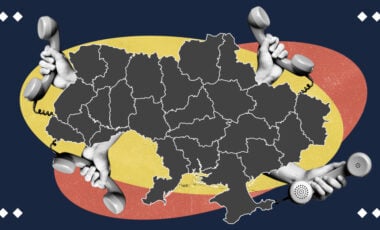Rubryka is the first media in Ukraine in the format of solution journalism. We talk not only problems, but also how they can be solved.Rubryka — Ukrainian Solutions MediaRubryka — Ukrainian Solutions MediaRubryka — Ukrainian Solutions MediaRubryka — Ukrainian Solutions MediaRubryka — Ukrainian Solutions MediaRubryka — Ukrainian Solutions Media %Rubryka — Ukrainian Solutions MediaRubryka — Ukrainian Solutions MediaRubryka — Ukrainian Solutions MediaRubryka — Ukrainian Solutions MediaRubryka — Ukrainian Solutions MediaRubryka — медіа корисних рішень для кожногоRubryka — Ukrainian Solutions Media
News
$71 Billion in Damages and 180 Million Tons of Emissions: Ukraine Highlights Environmental Impact of 1,000 Days of War at COP29
Eco-solutions: eight Ukrainian startups showcase climate solutions at Baku's COP29
Solutions from Ukraine: Ukraine fights against disinformation and promotes safe Internet through Digital Literacy Week
Top celebrities supporting Ukraine in 2024: from donations to advocacy
Italy hosts first exhibition of Ukrainian artists Rayko, Kadyrova, and Panchenko
Solutions from Ukraine: Ukrainian Veterans Fund launches information campaign to promote respect and support for all veterans
Ukrainian forces launch ATACMS missiles at Russian military site in Bryansk region
Russian army suffers equivalent losses in Ukraine every 10 days as 10 years in Afghanistan – FM Sybiha
Russia unleashes 2,500 missiles and drones on Kyiv during 1,000-day war, 50% in 2024 alone
Russia increases threats to stop US from approving Ukrainian use of US-provided ATACMS in Kursk region – ISW
Russian kamikaze drones leave six dead and 12 injured in Hlukhiv dormitory
Articles

The modern building of Okhmatdyt children's hospital damaged by a Russian missile will stay warm during winter despite all odds

Ukrainian Halloween: Five mystical creatures from Ukrainian folklore you can dress as

What to buy in Ukraine: 10 unique souvenir ideas

Music from Ukraine: Top 7 iconic Ukrainian songs you should know

Top celebrities supporting Ukraine in 2024: from donations to advocacy
Discover the stars who stood with Ukraine in 2024, raising awareness of Ukraine's fight to preserve its freedom.

Recharging Ukraine's change-makers: How resource center in Ivano-Frankivsk supports volunteers and activists

"Halabuda": how volunteers from Mariupol repaired thousands of larger drones

Serhii Rybalko: "If God forbid, war happened again, I'd go to the front again"

Solutions journalism works: Rubryka's ten best articles in October
Solutions for community development, comfortable cities, Ukrainian entrepreneurship and society inclusiveness.

Solutions journalism works: Rubryka's ten best articles in September

From struggle to healthy routine: Ukraine's RUN21 club shares how to fall in love with running

Solutions journalism works: Rubryka's ten best articles in August

Solutions journalism works: Rubryka's ten best articles in July

All-women teams in Ukraine defy stereotypes and rebuild homes destroyed by war
Until 2017, Ukrainian law restricted women from taking on jobs deemed dangerous or harmful to them. However, since the war began in 2014, Ukrainian women, despite these limitations, have worked as artillery soldiers, drivers, and construction workers and have taken on challenging tasks dangerous not just for women but for men, too. In a country at war, there's no room for discrimination because there's only one goal — victory. Rubryka shares the story of women volunteers from the initiative Repair Together, who, defying stereotypes, work on construction sites to help those affected by Russian aggression rebuild their destroyed homes.

Breaking barriers: Maryna Lytovchenko's journey from Paralympic glory to empowering women with disabilities

Ukrainian cafés join Pink October: What's the solution?

Barrier-Free Salon: Ukrainian volunteers bring inclusive beauty services to people with disabilities

"Every child gets their best chance": How the House of Butterflies brings hope to seriously ill Ukrainian children

How to support Ukraine and take care of your mental health: 10 therapist tips

"Every child gets their best chance": How the House of Butterflies brings hope to seriously ill Ukrainian children

From struggle to healthy routine: Ukraine's RUN21 club shares how to fall in love with running

Enhancing road safety: how the EU project is changing Ukrainian city infrastructure

How Lviv's "Take a House Under Guardianship" Initiative is reviving damaged properties after Russia's attack

Ukrainian cities install underground trash containers: Is it an effective solution?

Cats, dinosaurs, and sad service members: how to spot AI and avoid spreading fakes

How HelpPrint hotline brings vital support to Ukrainians in occupied territories























